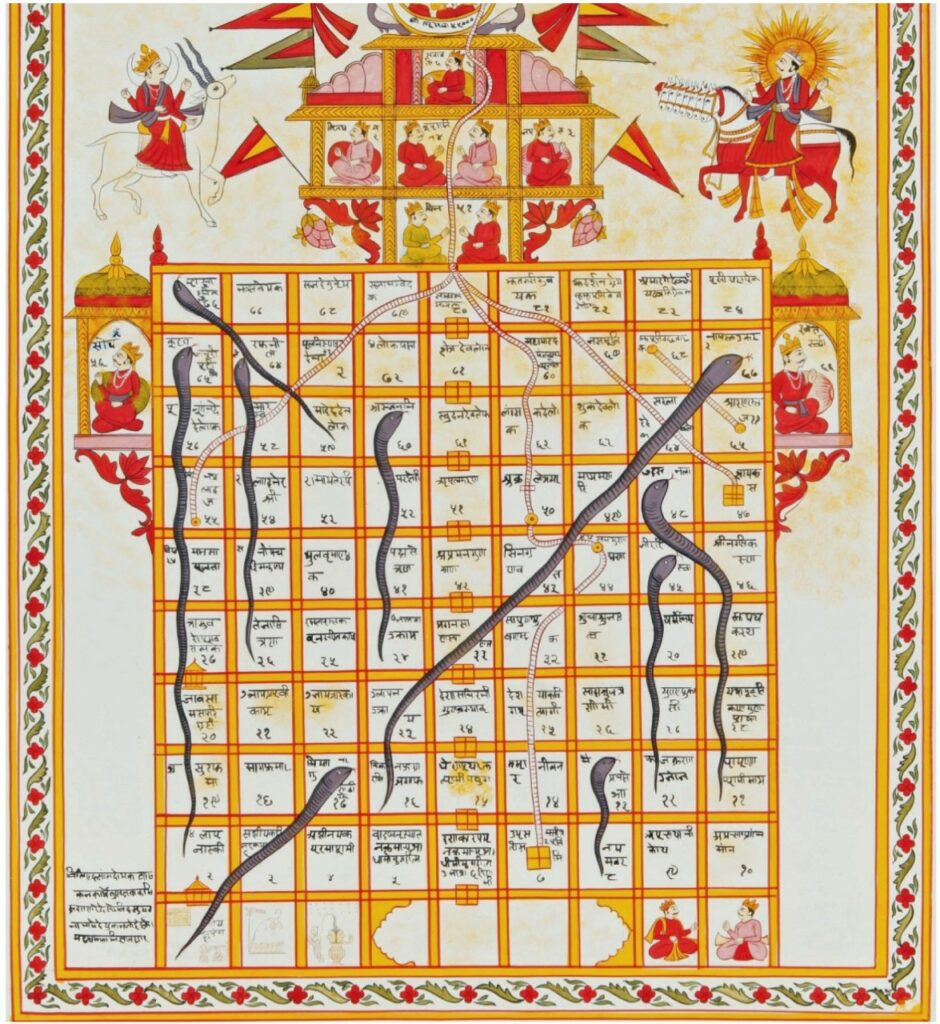A ton of incredible inventions have come from our country, other than giving the world the number zero, the most popular board games, snakes and ladders, originated in the eastern subcontinent of India.
Although now famous in its advanced, westernized structure as a children’s game, Snakes and Ladders follows its underlying foundations to a customary Indian board game dependent on strict methods of reasoning? In the first, it filled in as an exercise in ethical quality. Playing this game wasn’t just about winning or losing, however discovering how close you were, to paradise or hellfire.
The historical backdrop of Snakes and Ladders returns around 1000 years to tenth century CE whereas per a few historians, the game was created by Saint Gyandev in the thirteenth century AD while some trust it to have been invented by Jain priests to advance the idea of freedom from the servitude of passion. Truly we won’t ever know without a doubt when the game was designed and by whom.
Speaking about the game based on the invention of Jain priests, the game was emblematic of a man’s excursion throughout everyday life and the plan had a couple of similitudes with the antiquated Jain mandalas in which different squares were shown as the thought of karma and moksha.

As the priests went with the game, it obtained numerous local names like Gyan Chaupar in northern India and Mokshapat around Maharashtra, alongside Leela and Parampada Sopanapata .Meanwhile, other ‘philosophical’ varieties were created – a Hindu and an uncommon, Sufi Muslim rendition.
Suggested Read : Popular board games played in India
Additionally, it is to be noticed that dissimilar to the 100 squares game that is ubiquitous with the Snakes & ladder board game today, there wasn’t any normalization at that point. The most well-known sorts were 84-square Jain board, 101-square Sufi board and the 72 square Hindu (overwhelmingly Vaishnav) board, trailed by their extended variations, which in Pahari style can approach 360-squares. Frequently made basically of painted material and at times on paper, hardly few boards have survived from any earlier than the mid-eighteenth century. The iconography on it portrays cosmological components, with upper districts portraying heavenly creatures and the sky. The remainder of the board was covered with pictures of creatures, blossoms and individuals.
In the game, the ladders addressed excellences like confidence, liberality, quietude and parsimony while the snakes addressed indecencies like annoyance, robbery, desire and voracity. The last square addressed either a God or paradise meaning you have achieved freedom. The ladder passed on that great deeds lead you to paradise and evil to a pattern of re-births. The quantity of ladders was not exactly the quantity of snakes, an indication that the way of good is significantly harder to step, than a way of sins. Basically the game was intended to move players to introspect instead of compete with one another.

The game rotated around nothing but karma was on the grounds that it was with regards to the Jain philosophical thought – accentuating the thoughts of destiny and predetermination. This was as opposed to other old games, for example, Chaturanga which required expertise or Pachisi, which zeroed in on a combination of both.

The allure of this game rose above strict limits as well as geological ones. At the point when it was first brought to Victorian England in 1892 for example, it was a success. Here it was tweaked to suit Christian sensibilities. The squares of satisfaction, elegance and achievement were available by stepping stools of frugality and humility and snakes of guilty pleasure, rebellion and slothfulness made one end up in sickness, disrespect and destitution.
Suggested Download – Snakes & Ladders Pro Game App
While the Indian variant of the game had snakes more than ladders, the English version was really lenient, as it contained each (snake and ladder) in a similar sum. This idea of uniformity means the social ideal that for each wrongdoing one perpetrates, there exists one more opportunity at recovery.
The game is an intense showing instrument whose basic plan has been utilized for quite a long time, arguably even centuries, as a way to embody and reinforce religious teachings and cultural values.

In 1943, it was rebranded as Chutes and Ladders in the United States by game pioneer Milton Bradley. Over the long haul, the game was improved, deprived of good exercises through and through and in its new symbol, it came to be known as Snakes and Ladders board game.
Today, the classic snakes & ladders game is an overall work of art, and it is hard trying to discover even one kid that exist without having played the game. The game is basic and played on a game board with numbered, gridded squares. A few “ladders” and “snakes” are pictured on the board, each associating two explicit board squares. The object of the game is to navigate one’s game piece, according to die rolls, from the start, which is at the bottom of the board to the finish, marked on the top of the board, helped by climbing ladders but hindered by falling snakes.
This game fills in as an ideal illustration of how even a straightforward game can develop over the long haul and space. For this situation, additionally how a significant exercise in ethical quality, turned into a game kids play, that even today helps inculcate numerous qualities in kids like patience and the will to never give up along with the opportunity to bond with fellow players unlike any other board game.



